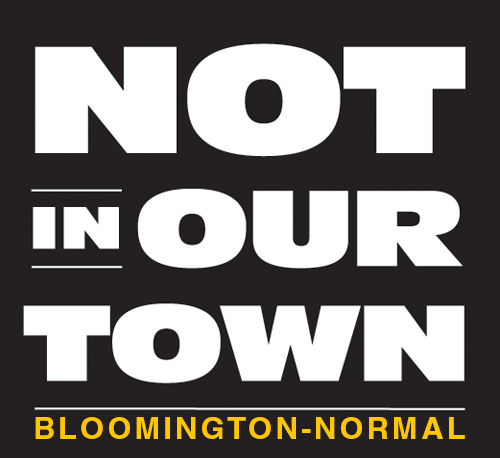This is Part 1 of a multi-part examination of Bloomington/Normal's challenges and successes in bridging social, economic, racial, and cultural concerns.
ISU's Frank Beck reviews conclusions of student researchers during a NIOTBN Steering Committee review of the study at Moses Montefiore Temple.
Key problems persist in the Twin Cities, according to a study by ISU students with the Stevenson Center for Economic and Community Development. But significant progress is being made, in part through efforts by NIOTBN and other local groups, "A Community Report on Intolerance, Segregation, Accessibility, Inclusion, Progress, and Improvement" concludes.
The Not In Our Town chapter in Bloomington-Normal recently asked two classes of students at Illinois State University to document intolerance, discrimination, segregation, disparities of access, and disparities in the criminal justice system in the twin cities. In this report, using archival material, secondary data, and primary data, the students examine these issues from the mid-1990s to the present. Not In Our Town also wanted to understand their position in the community and some strategies for future success, through an analysis of other organizations in the country similar to Not In Our Town.
The conclusion: “Bloomington-Normal was and is intolerant; discrimination did and does take place in this community; we are segregated. The community is also less of these things than it used to be and is less of these things than other places — thanks in part to the efforts of Not In Our Town.”
Interviews and focus groups document difficulties, progress, and hope for the future among community leaders, social service agencies, elected bodies, advocates, and law enforcement. Residents discuss systemic issues and the role of Not In Our Town in addressing them. Residents shared experiences of discrimination and intolerance from police, employers, and other community members. Some of the quotes drawn from the conversations “are powerful and are evidence of work yet to be done,” the study stressed.
Discrimination by law enforcement and a lack of access to quality food, health care, and employment are highlighted. Persons promoting racial equality, LGBTQ advocates, and residents provide ideas for future balance.
For example, data on traffic stops in eight Central Illinois cities and from the McLean County Detention Facility show inequities. Blacks are stopped more often and arrested more often than their share of the Bloomington-Normal population would predict. Vehicles driven by blacks are searched more often, yet drugs are more often found in vehicles of White drivers. Normal police stop vehicles at a far higher rate than police in the larger cities of Springfield or Peoria; the pattern is "quite stark." Without taking into account severity of charge, blacks that are arrested spend more time in the jail.
Bloomington-Normal is segregated, but far less than other Central Illinois communities, the students found. The index of dissimilarity for Bloomington-Normal shows that approximately 40 percent of black households need to change their residence in order to integrate each neighborhood to the same extent, across both cities. Since at least 1980, this number declined for Bloomington-Normal. Champaign, Decatur, Peoria, Rockford, Springfield, and Urbana experienced declines in their segregation too, but their values are still higher than Bloomington-Normal. We find that Springfield is the most segregated of these cities; the interaction index also shows Springfield to be the community where blackss are least likely to interact with a White person and vice versa.
One team of students mapped diversity in Bloomington-Normal against locations of health care facilities, tobacco and liquor stores, groceries with fresh produce, predatory lending establishments, banks, schools, and transit routes. There are disparities in access to these community attributes and the disparities differ by diversity of the neighborhood. In all, West Bloomington suffers from a lack of access to health care and fresh produce. Diverse neighborhoods have more access to fast food and convenient stores than they do quality grocers. Transit routes connect patrons to health care offices/facilities, banking, schools/community college, etc., but the costs in time are high. Predatory lending establishments are located on the community’s main routes, but proximate to economically disadvantaged populations.
The work of seven aspirational organizations from across the country is presented in the report. Based on the strengths of Not In Our Town, the Best Practices group identify characteristics of these model organizations that can further the local chapter’s efforts. From bylaws to organizational structure and activities, recommendations are made to increase participation, capacity, and credibility. Therefore, this project can help Not In Our Town identify its next steps.
“As community developers know, there is much to learn when we speak to one another about the state of affairs in our communities; not only can we better understand the situations our neighbors are experiencing, we can gather in collective action to work toward improvement and progress,” the study concludes. “This is the essence of Not In Our Town’s work and dedication.”

